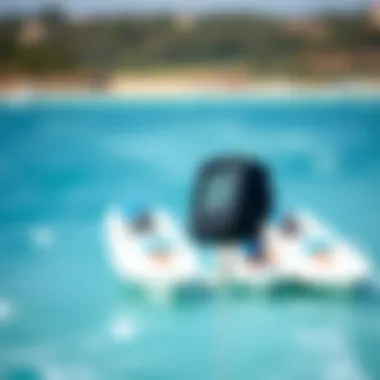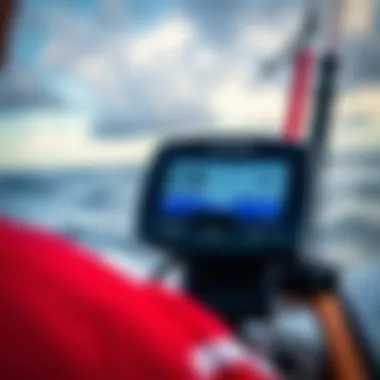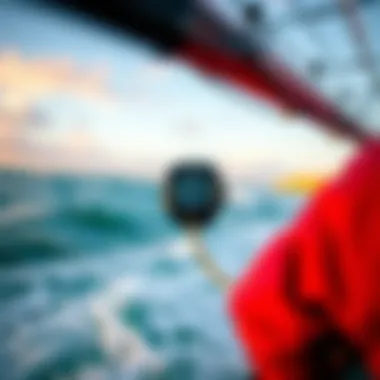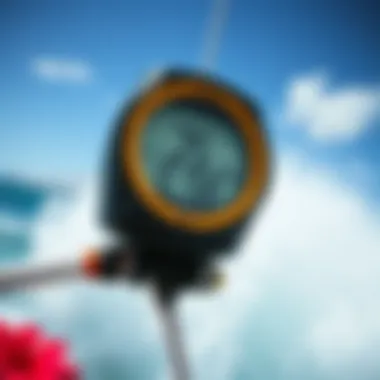Mastering Weather Flow and Meters for Kiteboarding


Intro
Kiteboarding is a thrilling sport that relies not just on skill, but heavily on the environment. Understanding weather flow and utilizing weather meters can mean the difference between an exhilarating ride and a perilous predicament. An informed kiteboarder is one who knows how to analyze wind patterns and weather conditions, ultimately enhancing their performance on the water while ensuring safety.
The factors influencing kiteboarding extend beyond the puffs of wind you might feel onshore. They include temperature, humidity, wind speed, and direction. Knowledge of these elements is vital for all kiteboarders, from beginners picking up their first set of lines to seasoned athletes preparing for competitions.
The world of weather is complex, yet crucial. With that said, kiteboarders can leverage technology to their advantage, using various tools to gauge and track weather changes. From anemometers to mobile apps that consolidate weather updates, there's a smorgasbord of options available.
Imagine heading out for a fifth or sixth round on the water, only to find that the winds have shifted dramatically or the tides were against you—resulting in an unexpected struggle. Our exploration is designed to share insights about these weather tools and how they can help you in your kiteboarding journey.
In this article, kiteboarding enthusiasts will discover how to select the right gear, understand essential techniques, and make progress in their skills, all grounded in a solid understanding of the weather. Let's take a deep dive into the essentials of gear selection, starting with what kites you should consider.
The Relevance of Weather in Kiteboarding
Weather plays a pivotal role in kiteboarding, an adventure that requires more than just skill and stamina. For enthusiasts and professionals alike, understanding the elements at play can mean the difference between an exhilarating ride and a perilous situation. Kiteboarders need to grasp weather conditions not just for enjoyment but also for ensuring safety and optimizing performance. The winds can change rapidly, and knowing when it's a breeze or a gale can safeguard against accidents. Specifically, wind speed, direction, and weather patterns directly affect both the control riders have over their kites and their overall experience on the water.
Impact of Weather on Kiteboarding Performance
The performance of a kiteboarder hinges on the interplay with their environment. Wind speeds dictate not only how smoothly a kite soars but also how safely a rider can maneuver.
- Light Wind Conditions: These may tempt novices to practice, but they can lead to frustrating experiences. A kite struggling to catch air can turn a promising session into an exercise in patience.
- Strong Wind Conditions: On the flip side, overestimating one's ability to handle stronger gusts can throw a surprising curveball. Riders can easily get overpowered, leading to miscalculations in jumps or turns, possibly resulting in falls.
- Wind Direction: Understanding where the wind is blowing from helps in setting up optimal launches and landings, crucial for avoiding obstacles and maintaining control.
Developing an accurate sense of how these factors interact can significantly enhance performance. For seasoned riders, this knowledge becomes second nature, helping them excel in competitions or during casual outings on the waves.
Understanding Wind Patterns
Wind patterns form the backbone of kiteboarding conditions, determining not only safety but also performance capabilities. Relying solely on gusty feelers is akin to sailing blindly through a storm.
- Local Effects: Riders should be aware of how local geography influences wind. Valleys, hills, and buildings can channel or disrupt winds, resulting in varying conditions even over short distances. Wind shadow areas might provide calm spots, while boundaries outside them may harbor powerful gusts.
- Global Patterns: Larger systems, such as trade winds, can influence local conditions. For example, during certain seasons, regional wind shifts can transform a calm beach into a kiteboarding haven or a hazardous zone.


Moreover, riders need to be cognizant of how quickly these patterns can shift based on temperature changes or approaching weather fronts. Having a keen eye on the horizon can provide vital clues, allowing kiteboarders to preemptively adjust their plans. Simple observations, like sudden wind changes or dark clouds forming, can indicate an impending storm, thus ensuring a timely exit from the water.
In summation, understanding weather dynamics can greatly assist kiteboarders in navigating their experiences. Insight into weather flow, wind conditions, and patterns equips riders with the tools they need to harness, rather than fear, the elements.
Defining Weather Flow
Understanding weather flow is fundamental for kiteboarders who seek to improve their performance while ensuring their safety on the water. This concept encompasses the movement of air and its various interactions with environmental factors such as geography and temperature. With varying wind patterns, temperature shifts, and other climate variables, kiteboarding can be both exhilarating and perilous. Thus, grasping the nuances of weather flow is not merely beneficial; it is essential for anyone who wants to harness the wind effectively.
Conceptual Overview
At its core, weather flow is driven by the differences in air pressure, where the air tends to move from regions of high pressure to low pressure. This basic principle highlights why specific geographical locations tend to be more favorable for kiteboarding. For instance, coastal areas with open water might experience steadier wind patterns compared to landlocked regions.
Several key components contribute to weather flow:
- Air Pressure: Variations in air pressure can create wind. The greater the difference between high and low pressure, the stronger the wind.
- Topography: Mountains, valleys, and even buildings influence how wind travels. In particular, mountains can create turbulence or funnel winds, drastically affecting kiteboarding conditions.
- Thermal Gradients: The sun heats surfaces unevenly, causing different air temperatures that can create local winds. Understanding this can help kiteboarders predict changes in wind intensity throughout the day.
Kiteboarders who are familiar with these aspects can better anticipate the changes in weather and wind patterns, which ultimately enhances their on-water experience.
Mechanics of Weather Flow
Weather flow operates through fundamental mechanics that can directly impact kiteboarding. The two crucial elements are wind speed and wind direction, both of which are influenced by the aforementioned factors.
- Wind Speed
- Wind Direction
- The speed of the wind is a chief factor in deciding whether conditions are suitable for kiteboarding. Strong winds can provide exhilarating rides but can also lead to dangerous situations. Therefore, knowing how to measure wind speed with a reliable anemometer and acknowledging the implications of varying wind speeds is critical.
- Kiteboarding requires an understanding of wind direction—whether it's onshore, offshore, or cross-shore. Each type of wind direction presents its own set of challenges and advantages. For example, onshore winds are usually safer for beginners, as they blow towards the land, while offshore winds can lead to potentially hazardous situations as they blow away from the shore.
Effective kiteboarders continuously monitor how weather flow interacts with both environmental factors and their equipment---a skill that separates proficient riders from novice ones.


By comprehending these mechanics, kiteboarders can develop strategic plans for their outings. This knowledge is also beneficial in evaluating potential hazards, as rapidly changing conditions can expose riders to unexpected dangers. In essence, understanding weather flow equips kiteboarders with the knowledge to navigate these complexities intelligently, allowing them to enhance their skills while minimizing risk.
Prelude to Weather Meters
Understanding weather meters is a cornerstone of successful kiteboarding. These devices provide essential data that significantly impacts performance and safety on the water. With the right information about wind speed, air pressure, and humidity, kiteboarders—whether experienced or just starting out—can make informed decisions about when and where to ride. This article section will explore the fundamentals of weather meters and how they can enhance kiteboarding experiences by allowing riders to align their skills with environmental conditions.
What is a Weather Meter?
A weather meter is an instrument designed to measure various atmospheric conditions that can affect kiteboarding. Typically, these devices gauge wind speed, air pressure, and humidity, feeding kiteboarders crucial data while they prepare for or assess their next ride.
If you think about it, knowledge is power in this sport. A novice might get blown away—literally—during an unexpected gust of wind, while a seasoned rider can harness the same conditions to soar. Imagine standing on the shore, soaking in the sun, and having a gadget that whispers secrets about the wind at your fingertips.
Types of Weather Meters
Different types of weather meters cater to a variety of needs in kiteboarding. Each of these hosts its own unique set of functionalities and advantages.
Anemometers
Anemometers are primarily used to measure wind speed. Their role is critical in kiteboarding; after all, wind is what powers the kites. Most anemometers come with a rotating set of cups or propellers, which spin faster as wind velocity increases.
One standout quality of anemometers is the real-time data they provide, allowing riders to instantly gauge conditions before taking to the water. This immediate feedback is crucial when deciding whether the conditions fit your skill level. However, keep in mind that anemometers often need to be calibrated for accuracy, which could be a downside for some users who prefer a plug-and-play experience.
Barometers
Barometers are another key piece in the weather meter puzzle, mainly measuring atmospheric pressure. For kiteboarders, changes in pressure can indicate shifting weather conditions, including incoming storms or changing wind patterns.
A barometer's most valuable feature is its ability to help predict weather changes, essentially offering you a sneak peek at what's to come. Riders attuned to pressure shifts can make snares ahead of inclement weather—saving grace for avoiding dangerous conditions. But on the flip side, barometers may not provide immediate wind speed data, so pairing them with an anemometer can be a wise move.
Hygrometers


Lastly, hygrometers measure humidity levels and air moisture. This might not appear vital at first glance, but understanding humidity can help kiteboarders anticipate how the water and air feel, which affects how your kite handles.
The key trait of hygrometers is their ability to provide insights into the air's moisture content, linking temperature and comfort levels. For instance, during high humidity, the air can feel heavier, potentially affecting kite performance. However, keep in mind that hygrometers usually don't tackle wind speed or pressure, which is another reason to consider integrating various weather meters.
"Embracing the instruments of nature empowers kiteboarders to become adept navigators of both sport and environment."
In closing, understanding these different weather meters and their unique functions can empower kiteboarders to adapt to ever-changing conditions. With the proper data at hand, riders can enhance their safety and performance, fully enjoying their time on the water.
Functionality of Weather Meters in Kiteboarding
Weather meters are more than just gadgets; they are invaluable tools that can make the difference between a thrilling experience and a hazardous one on the water. Understanding their functionality is crucial for kiteboarders of all skill levels. Using weather meters correctly enhances performance and makes informed decisions while keeping safety at the forefront.
Understanding Wind Speeds
Wind speed is the lifeblood of kiteboarding—it propels the kite and defines the ride's dynamics. Weather meters assist in capturing real-time wind speeds, which is essential for kiteboarders. When a rider knows the wind speed, they can select the appropriate equipment. For instance, a light breeze of 10 to 15 knots may require a bigger kite for optimal lift, while stronger winds over 20 knots usually call for smaller kites to mitigate risk.
A significant aspect of measuring wind speed is understanding the scale. Weather meters typically display wind speeds in knots, miles per hour, or kilometers per hour. Here are some key points to consider:
- Wind Gauge: Most weather meters have an anemometer to measure wind speed accurately. This device usually features rotating blades that detect wind flow.
- Wind Variability: Riders may notice that wind speeds can fluctuate significantly, even within a short time frame. Instantaneous data helps make quick decisions to either ride or wait it out.
- Average and Maximum Speeds: Many weather meters also display average and maximum wind speeds over a set period. This data can provide context—helping riders understand whether conditions are stable or changing.
Collectively, this information keeps everyone out there safer and more in tune with their environment. In kiteboarding, ignorance is not bliss—it can be downright hazardous.
Measuring Humidity and Temperature
Humidity and temperature are often the unsung heroes in the kiteboarding weather equation. They can affect performance just as much as wind speed. High humidity can make it feel warmer than the actual temperature, possibly leading to heat exhaustion if riders are not careful. Likewise, temperature can affect how equipment performs, particularly materials in the kite and lines.
Understanding how weather meters assess these elements is vital:
- Hygrometers: These devices are part of most weather meters and provide humidity readings. For kiteboarders, knowing the humidity can help manage hydration and prepare for possible weather changes.
- Thermometers: Integrated thermometers show the current air temperature. This data is significant, as it helps gauge attire. A chilly day might encourage a thicker wetsuit.
- Ideal Conditions: Typically, kiteboarders seek air temperatures around 60°F to 85°F when combined with stable wind conditions. Knowing the humidity can add another layer of understanding—more moisture may invite clouds and possible rain.
Typical Range Choices for Kiteboarding:
- Optimal Wind Speed: 10-20 knots
- Air Temperature: 60°F to 85°F
- Humidity: 40% to 70% for comfort















